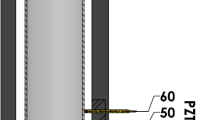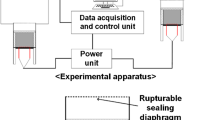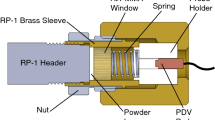Abstract
The brightness temperature and pressure profiles of the detonation products of pressed charges of benzotrifuroxane were determined by a pyrometric method, and the heat of explosion and propellant performance were experimentally determined. The temperature of the detonation products (4100±150 K) was significantly lower than the calculated values reported in most theoretical papers. Compared to HMX, benzotrifuroxane has a higher heat of explosion but lower expansion velocity of the shell (T-20) method and Gurney energy.
Similar content being viewed by others
References
Energetic Condensed Systems: A Brief Encyclopedia, Ed. by B. P. Zhukov (Yanus-K, Moscow, 2000) [in Russian].
V. I. Pepekin, M. N. Makhov, and Yu. A. Lebedev, “Heat the Explosive Decomposition of Individual Explosives,” Dokl. Akad. Nauk SSSR 232(4), 852–855 (1977).
B. M. Dobratz, “LLNL Explosives Handbook Properties of Chemical Explosives and Explosive Simulants, Report No. UCRL-52997 (Lawrence Livermore Laboratory, March, 1981).
L. E. Fried and P. C. Souers, “BKWC: An Empirical BKW Parametrization Based on Cylinder Test Data, Propellants, Explosives, Pyrotechnics 21(4), 215–223 (1966).
A. P. Ershov, “Explosion,” Soros. Obraz. Zh. 6(1), 85–90 (2000).
M. Finger, E. Lee, F. H. Helm, et al., “The Effect of Elemental Composition on the Detonation Behavior of Explosives,” in Proc. Sixth Symp. (Int.) on Detonation, ACR-221 (Coronado, California, 1976), pp. 710–722.
S. B. Viktorov, S. A. Gubin, and I. V. Maklashova, “Prediction of Detonation Properties of a CNO Composition Based on the Properties of Ultrafine Carbon,” in Physics of Extreme States of Matter 2002, Ed. by V. E. Fortov, V. P. Efremov, K. V. Khishchenko, et al. (Inst. of Problems of Chemical Physics, RAS, Chernogolovka, 2002), pp. 88–90 [in Russian].
B. P. Tolochko, V. M. Titov, A. P. Chernyshev, et al., Physicochemical Model of Detonation Synthesis of Nanodiamonds (Budker Inst. of Nuclear Phys., SB RAS, Novosibirsk, 2005) [in Russian].
I. S. Tselinskii, “Use of Energetic Materials in Technology and Industry,” Soros. Obraz. Zh. 3(11), 46–52 (1997).
A. A. Kotomin, S. A. Dushenok, V. V. Efanov, et al., “Critical Detonation Diameter of Explosive Materials used in Separation Systems of Spacecraft,” Vestn. FGUP NPO Lavochkina, No. 1, 24–31 (2010).
V. M. Titov, V. F. Anisichkin, and I. Yu. Mal’kov, “Synthesis of Ultradispersed Diamond in Detonation Waves,” Fiz. Goreniya Vzryva 35(3), 117–126 (1989) [Combust., Expl., Shock Waves 35 (3), 372–379 (1989)].
V. F. Anisichkin, D. S. Dolgushin, and E. A. Petrov, “The Effect of Temperature on the Growth of Ultrafine Diamonds in the Front DV,” Fiz. Goreniya Vzryva 31 (1), 109–112 (1995) [Combust., Expl., Shock Waves 31 (1), 106–109 (1005)].
D. L. Ornellas, “the Heat and Products of Detonation in a Calorimeter of CNO, HNO, CHNF, CHNO, CHNOF, and CHNOSi Explosives,” Combust. Flame 23(1), 37–46 (1974).
M. J. Kamlet, J. M. Short, M. Finger, et al., “The Chemistry of Detonations. VIII. Energetic Relationships on the Detonation Isentrope,” Combust. Flame, No. 3, 325–333 (1983).
M. F. Gogulya and M. A. Brazhnikov, “Temperatures of the Detonation Products of Condensed Explosives. I. Solid Explosives,” Khim. Fiz. 13(1), 52–63 (1994).
M. F. Gogulya and A. Yu. Dolgoborodov, “Indicator Method of Studying Shock and Detonation Waves,” Khim. Fiz. 13(12), 118–127 (1994).
M. N. Makhov, “Determination of the Energy Content of Individual Explosives,” Khim. Fiz. 19(6), 52–56 (2000).
M. N. Makhov, “Determination of the Heat of Explosion of Aluminized Explosives,” in Combustion and Explosion, Ed. by S. M. Frolov (Torus Press, Moscow, 2011), Vol. 4, pp. 307–312 [in Russian].
Physics of Explosion, Ed. by L. P. Orlenko (Fizmatlit, Moscow, 2002), Vol. 1 [in Russian].
Methods of Studying the Properties of Materials under Intense Dynamic Loading, Ed. by M. V. Zhernokletov (VNIIEF, Sarov, 2003) [in Russian].
D. R. Hardesty and J. E. Kennedy, “Thermochemical Estimation of Explosive Energy Uutput,” Combust. Flame 28(1), 45–49 (1977).
H. Hornberg, “Determination of Fume State Parameters from Expansion Measurements of Metal Tubes,” Propellants, Explosives, Pyrotechnics 11(1), 23–31 (1986).
M. F. Gogulya, A. Yu. Dolgoborodov, M. A. Brazhnikov, et al., “Detonation Waves in HMX/Al Mixtures (Pressure and Temperature Measurements),” in Proc. Eleventh Symp. (Int.) on Detonation, ONR 33300-5 (Snowmass, Colorado, 1998), pp. 979–988.
M. F. Gogulya, A. Yu. Dolgoborodov, M. N. Makhov, et al., “Detonation Performance of Aluminized Compositions Based on BTNEN,” in Proc. Twelfth Symp. (Int.) on Detonation, ONR 333-5-2 (San Diego, California, 2002), pp. 249–255.
V. M. Titov, K. A. Ten, E. R. Pruuel, B. P. Tolochko, “Synchrotron Diagnostics of Explosive Processes,” in Extreme States of Matter. Detonation. Shock Waves, Ed. by A. L. Mikhailov (VNIIEF, Sarov, 2011) [in Russian].
M. N. Makhov and V. I. Pepekin, “Calculation of Chemical Composition of Detonation Products,” Polish J. Chem. 55(6), 1381–1385 (1981).
M. N. Makhov, “The Effect of Charge Density on the Explosion Heat of High Explosives,” in Proc. 33rd Int. Annu. Conf. ICT (Karlsruhe, FRG, 2002), pp. 73/1–73/13.
J.-F. Danel and L. Kazandjian, “A Few Remarks about the Gurney Energy of Condensed Explosives,” Propellants, Explosives, Pyrotechnics 29(5), 314–316 (2004).
V. I. Pepekin and S. A. Gubin, “Propellant Performance of Organic Explosives and Their Energy Output and Detonation Velocity Limits,” Fiz. Goreniya Vzryva 42(1), 99–111 (2007) [Combust., Expl., Shock Waves 42 (1), 84–95 (2007)].
Author information
Authors and Affiliations
Corresponding author
Additional information
Original Russian Text © A.Yu. Dolgoborodov, M.A. Brajnikov, M.N. Makhov, N.E. Safronov, V.G. Kirilenko.
__________
Translated from Fizika Goreniya i Vzryva, Vol. 49, No. 6, pp. 112–120, November–December, 2013.
Rights and permissions
About this article
Cite this article
Dolgoborodov, A.Y., Brajnikov, M.A., Makhov, M.N. et al. Detonation parameters of pressed charges of benzotrifuroxane. Combust Explos Shock Waves 49, 723–730 (2013). https://doi.org/10.1134/S0010508213060129
Received:
Published:
Issue Date:
DOI: https://doi.org/10.1134/S0010508213060129




